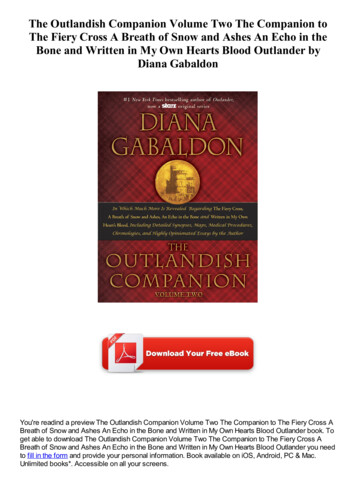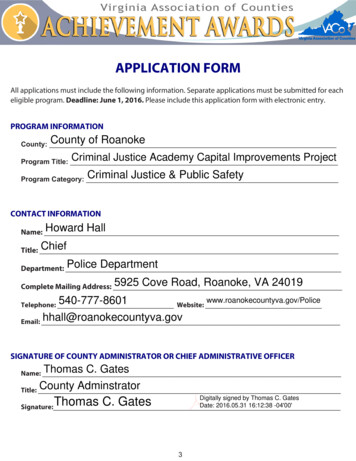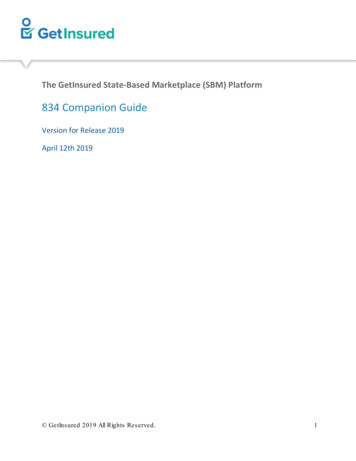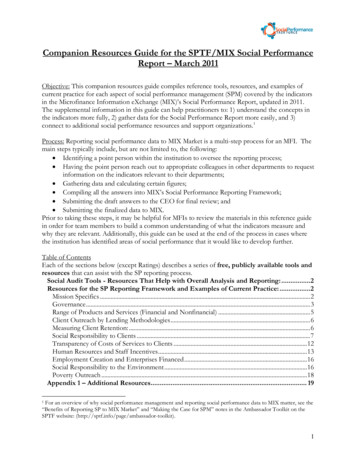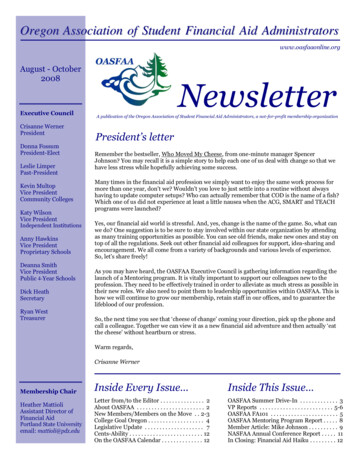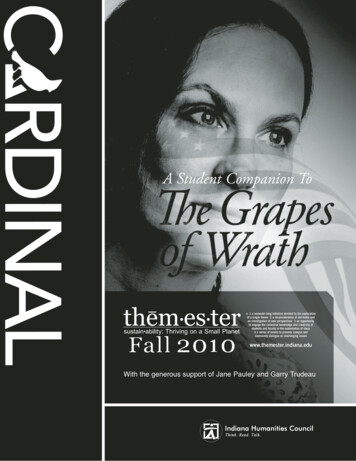
Transcription
A Student Companion ToWith the generous support of Jane Pauley and Garry TrudeauTheRaymondFoundation
Contentssection 1:The Book and Its Contextpage2 Who Was John Steinbeck? Ellen MacKaypage3 What Was the Dust Bowl? Ellen MacKaypage6 Primary SourcesSteinbeck Investigates the Migrant Laborer CampsEllen MacKay: Dorothea Lange’s “Migrant Mother” and the Look of the Dust BowlThe Novel’s ReceptionpageThe Wider Impact of The Grapes of Wrath10 What Makes The Grapes of Wrath Endure?Jonathan Elmer: Steinbeck’s Mythic NovelGeorge Hutchinson: Hearing The Grapes of WrathChristoph Irmscher: Teaching The Grapes of Wrathsection 2:Sustainability, Bloomington, and the World of The Grapes of Wrathpage14 What Does Literature Have to Do with Sustainability? Ellen MacKaypage15 Nature Writing Now: An Interview with Scott Russell Sanderspage18 What Can Be Done?: Sustainablilty Then and NowAn Excerpt from A Conservationist Manifesto Scott Russell SandersMichael HamburgerSara PryorMatthew AuerTom Evanspage22 Primary Access: The 1930s in Our MidstEllen MacKay: Thomas Hart Benton, the Indiana Murals, and The Grapes of WrathNan Brewer: The Farm Security Administration Photographs: A Treasure of the IU Art MuseumChristoph Irmscher: “The Toto Picture”: Writers on Sustainability at the Lilly Librarysection 3:The Theatrical Event of The Grapes of Wrathpage 26pageHow Did The Grapes of Wrath Become a Play? Ellen MacKay27 The Sound of The Grapes of Wrath:Ed Comentale: Woody Guthrie, Dust Bowl Ballads, and the Art and Science of Migratin’Guthrie Tells Steinbeck’s Story: The Ballad of “The Joads”page31 Another Look at the Joads’ Odyssey: Guthrie’s Illustrations. An Interview with Randy Whitesection 4:Recommended Resources and EventsA page from the manuscript ofSteinbeck’s The Grapes of Wrathcourtesy of the Library of Congress.
Welcome To the Show!The College of Arts and Sciences at Indiana University ispleased to welcome you to the Cardinal Stage production ofThe Grapes of Wrath. This fine adaptation of John Steinbeck’sgripping novel is produced in connection with the College’s2010 Themester initiative, “sustain ability: Thriving on a SmallPlanet,” a semester-long program that combines academiccourses, public lectures and exhibits, film showings, and otherevents connected to this most vital topic. While this programprominently features interconnected coursework for IndianaUniversity students, many events—like this production of TheGrapes of Wrath—are open to the public.Forming the core of this initiative are over two hundredinter-related courses on the Bloomington campus that rangein topic from ecology to creative writing, from economic andpublic policy to conservation, energy, and climate change.In addition, a number of spectacular events are planned for eachmonth of the fall semester to which all are invited. In October,for example, Patten and Branigan lecturers, world-renownedexperts invited by IU Faculty, will address topics of crucialimportance to sustainability: climate change and tropicalconservation. In November, highly acclaimed writers ThomasFriedman, author of The World is Hot, Flat, and Crowded, andWendell Berry will give public lectures on campus. StraddlingOctober and November, SoFA gallery will host an exhibition ofartist and activist Subhankar Banerjee, a prominent naturephotographer, while the IU Art Museum offers sustainabilitythemed tours throughout the semester. Other events includescreenings and discussions of films such as The 11th Hour andAn Inconvenient Truth.Themester, a semester-long initiative launched bythe College of Arts and Sciences and Dean Bennett Bertenthalin 2009, is intended to engage students and the entirecommunity in a collective learning experience about a timely,even urgent, issue. The 2011 topic, “War and Peace,” willcontinue in this spirit. To read more about Themester and toaccess a Calendar of Events, please visit the Themester homepage at http://themester.indiana.edu/.Stephen WattAssociate Dean for Undergraduate EducationCollege of Arts and SciencesIndiana UniversityCardinal Stage is thrilled to be presenting The Grapes of Wrathin collaboration with the College of Arts and Sciences’ secondThemester, on sustain ability. We extend special thanks toKirstine Lindemann and Stephen Watt for their unflaggingsupport. As it did last year, the Themester initiative has helped usto reach out to more students and engage the community moredeeply and broadly than ever before; it represents a wonderfulextension of IU’s intellectual and social interests into the town ofBloomington and beyond. We are thrilled to be a part of it.The materials in this educational packet are meant to enrichthe experience of seeing The Grapes of Wrath by illuminatingSteinbeck’s Dust Bowl milieu, its vibrant traces in Bloomington,and its wider world of literary, historical and ecological context.The contributors to this work deserve special thanks: MatthewAuer, Nan Brewer, Ed Comentale, Jonathan Elmer, Tom Evens,Michael Hamburger, George Hutchinson, Christoph Irmscher,Sara Pryor, and Scott Sanders. Thanks, too, to intern EmilyMacDonald, for her research and transcription, and to EllenMacKay, Cardinal’s Director of Educational Outreach, forassembling, editing and contributing this outstanding document.Cardinal Stage Company takes it as its mission to make worldclass theatre and high-quality educational programmingaccessible to all local children and families. We are able to achievethis mission thanks to the financial support of the BloomingtonCommunity Arts Commission and the City of Bloomington,and because of a very generous grant in support of this Themestercollaboration from Jane Pauley and Garry Trudeau.And now, enjoy!Yours,Randy White
section 1:The Book and Its ContextWho Was John Steinbeck?by Ellen MacKayJohn Steinbeck was born in 1902 in Salinas, California, a regionknown as The Salad Bowl of the Nation for its record output ofvegetables and fruits. His family was prominent but modest ofmeans; his father, at one time the treasurer of Monterey County,tried out several lines of work, including feed store owner andflour mill manager. Steinbeck later wrote evocatively of his happychildhood, spent in the dazzling outdoors. Weekends on the coastand weekdays in the valley helped to develop his particular regionalflavor—Steinbeck is often recognized as a founding father ofCalifornian fiction.In 1919 he enrolled atStanford University butfollowed no particularcourse of study. Heearned the money to payfor his classes in English,Classics, Compositionand Natural Science byworking summers onfarms and ranches; theexperience cemented hisJohn Steinbeck in a photographlifelong empathy forfrom the 1930s.agricultural laborers andhis perception that the soul of America resided in its soil. After sixyears at Stanford and without a degree, Steinbeck tried his luckas a journalist in New York. The experiment was a failure, and hereturned to California to turn his hand to novel-writing. The 1930swere a period of tremendous productivity for Steinbeck. His firstreal success, Tortilla Flat (1935), was a comic tale about the alcoholfueled exploits of four paisanos in pre-Prohibition Monterey.The book was made into a 1942 movie starring Spencer Tracyand provided Steinbeck enough money to buy a home and theconfidence to embrace his career choice. He followed it up with aseries of novels that became known as his Dust Bowl trilogy:In Dubious Battle (1936), Of Mice and Men (1937), and The Grapes ofWrath (1939). Each of these took up the subject of migrant farmlabor and the cultural forces that ignored, sentimentalized orexploited them. Of the three works, The Grapes of Wrath wasconsidered Steinbeck’s greatest triumph. An advance edition ofnearly 20,000 copies sold out immediately, and at the height of itspopularity, the book sold 10,000 copies a week. In 1940, it wonthe Pulitzer Prize, and it remains one of the most read and admiredworks of Depression-era literature. The novel’s reputation wasenhanced by John Ford’s film adaptation (released 1940), starringHenry Fonda, for which Ford won the Oscar for Best Director.At the moment of its release, however, the book was decidedlycontroversial. Californian farmers objected to their depiction asexploitative and unfeeling; some Oklahoma migrants denouncedthe squalid picture they felt Steinbeck offered of their day-to-dayexistence. One California County banned it for irreligiouscontent, bad language and socialist politics, but the effect wasonly to entrench the novel’s reception as an extremely timelywork, perfectly attuned to the complex interplay of Americanindividualism and the spirit of collective uplift that pervaded thepre-war Roosevelt era.Surprisingly, Steinbeck’s next book did little to capitalizeupon his success. Exhausted from his research in the Okie camps,a strained marriage and ill health, he set off with his friend EdRicketts, a longtime friend and marine biologist, to study theecology of the Sea of Cortez. He and Ricketts published a catalogueand a chronicle of the species they collected in 1941 called TheSea of Cortez. Critics have come to see Steinbeck’s collaborationwith Ricketts as deeply influential; the documentary style thatcharacterizes Steinbeck, and in particular, his non-teleologicalstructure (in other words, his tendency to let things play outwithout driving toward any particular end or purpose) have beenattributed to Ricketts’s scientific philosophy.Steinbeck then turned his attention to the war effort, andbecame a correspondent for the New York Herald Tribune in1942 (his columns were later collected in Once There Was a War,published in 1958). His post-warworks, Cannery Row (1945) andThe Pearl (1947) were not embracedby critics, and Steinbeck’s mostvisible influence was as a writer forthe cinema: his screenplay for EliaKazan’s Viva Zapata! (1952) andthe film adaptation of his East ofEden (1955, starring James Dean)brought him more popular successthan his fiction. After East of Eden,he ceased working on novelsentirely; his last successful book,Travels with Charley (1962), returnsto the travel-log style Steinbecktried out in The Sea of Cortez.The poster for John Ford’sfilm adaptation of The GrapesIn 1965 he received the Nobelof Wrath. The film clearlyPrize; the experience was somewhatcapitalized on the runawaymarred by a piece that ran in Thesuccess of Steinbeck’s novel.New York Times the day after the
the book and its context3Depression-era disenfranchised; by the 1960s, The Grapes of Wrathwas viewed by some as a period piece, and Steinbeckas an author long past his prime. But scholars now tend torecognize the allegorical strain of Steinbeck’s later writing styleas experimental rather than didactic, and they point out that hispolitics are not merely an ideologue’s reaffirmation of the leftistbottom line. In his Dust Bowl trilogy, he is as likely to exposethe exploitation of workers by pro-union agitators as he is toindict the callousness of business owners. Steinbeck said himselfthat he wished to be remembered for his commitment to storiesthat enlarge humanity’s capacity for compassion and mutualrespect. As he explained when he accepted his Nobel Prize:Mr. and Mrs. Frank Pipkin being recorded by Charles Todd (left) at the ShafterMigratory Labor Camp, Shafter, California, 1940. Photograph by RobertHemmig. Charles L. Todd and Robert Sonkin Migrant-Worker Collection.Courtesy of the American Folklife Center, Library of Congress. Mrs Pipkin isthought by many to have been the inspiration for Mrs. Joad in Steinbeck’s TheGrapes of Wrath. Steinbeck met Pipkin (and Todd) while researching his novel.announcement, “Does a Writer with a Moral Vision of the 1930sDeserve the Nobel Prize?” As the title implies, Steinbeck was neverquite able to break free of his reputation as a spokesperson for theThe ancient commission of the writer has not changed.He is charged with exposing our many grievous faults andfailures, with dredging up to the light our dark and dangerousdreams for the purpose of improvement. Furthermore,the writer is delegated to declare and to celebrate man’sproven capacity for greatness of heart and spirit — for gallantryin defeat, for courage, compassion and love. In the endlesswar against weakness and despair, these are the bright rallyflags of hope and of emulation.What Was the Dust Bowl?by Ellen MacKay“The Dust Bowl” is a phrase coined by Robert Geiger, anAssociated Press journalist who was traveling through Oklahomaon April 14, 1935, the day the worst of the dust storms hit. Geigerwrote about a fast-moving cloud of desiccated soil so thick itblocked drivers from seeing the hoods of their own cars as theystruggled to escape it.Woody Guthrie wrote a song about the storm:On the fourteenth day of April of nineteen thirty five,There struck the worst of dust storms that ever filled the sky.You could see that dust storm comin’, the cloud lookeddeathlike black,And through our mighty nation, it left a dreadful track.—Woody Guthrie (1912-1967).From “Dust Storm Disaster”Black Sunday, as April 14th came to be known, was theculmination of a terrible confluence of harsh weather, economicdesperation and agricultural mismanagement that spanned adecade and altered America’s environmental consciousnessHerschel C. Logan, Dust Storm, 1938. From the collection of the Universityof Kansas Spencer Museum of Art.forever. By 1930, East Coast families were heading to the plainsin great numbers to escape the crushing conditions of theDepression. Oklahoma, Kansas, Colorado, New Mexico and Texaswere advertised to eager migrants as wheat-bearing Edens, with
4cardinal stage company * the grapes of wrathsoil so rich that anyone with an acre and a tractor could be certainto secure a decent living. The Southern Plains soon filled withinexperienced farmers who plowed up millions of acres of virginsod and planted and re-planted the same terrain to eke everydime they could out of it. When the summer of 1931 turned verydry, the wheat withered in the fields and the thin layer of parchedtopsoil turned to dust, which was picked up by the area’s strongwinds and blown into the air. Dust invaded homes and settledinto people’s eyes and throats, causing a respiratory ailmentcalled dust pneumonia. The Red Cross sent masks for students towear to school and mothers doused their children with dubioushome remedies like turpentine and skunk oil to ease theirbreathing. But the drought lingered, and conditions worsened.Buried machinery in barn lot in Dallas, South Dakota. Image courtesy ofthe United States Department of Agriculture.Farmers responded by redoubling their efforts for eachensuing harvest. As the drought continued from 1931 to 1935,more and more dust was sheared off the fields and sent into theatmosphere, causing huge dust storms to rage across the plains.When crop after crop failed, families began abandoning theirfarms to head for greener pastures in the Pacific Northwest.By 1940, fully one quarter of the panhandle population, orroughly 500,000 people, had abandoned the afflicted states.The migration westward, largely to California’s fecund SanJoaquin Valley, took on complex political dimensions. Before1941, states held the right to restrict interstate travel. California’s1933 Indigent Law barred travelers without a documented meansof support the right to settle in the state. Los Angeles’s infamous“Bum Blockade” (1936) sent police to major railway and roadcrossings to turn back desperate migrants. Hostility to refugeesstemmed from the cost of supporting this new population;because the farm states had lobbied successfully to keep NewDeal labor laws from extending to agricultural work, the onlygovernment support available to strapped crop-picking familieswas state-based. Already suffering from high unemployment,California sought to keep down its welfare rolls by keeping thepoor out. Those that did manage to resettle in the San JoaquinValley forced the expansion of other state amenities, includingschools and municipal hospitals. New facilities required a rise inlocal taxes, which again increased the local resentment of Okies(as most Dust Bowl refugees were then called, though only about20% were from Oklahoma). Meanwhile, farm owners exploitedthe heavy influx of eager workers by paying impossibly low wages.Families settled into makeshift camps with no plumbing orelectricity; children as young as four and five were forced to pickcotton to help sustain their households. When floods washedthrough the valley in 1938, the resulting crisis in employment,health and hygiene became a national disgrace.By the mid-1930s, various artists including DorotheaLange, Woody Guthrie and John Steinbeck were already at workdescribing the Okie migration. After the floods, their workcaught the attention of the national press and touched off a waveof outrage. With the publication of The Grapes of Wrath, EleanorRoosevelt came to California to tour the camps and discussmigrant issues with California authorities. The ACLU challengedthe legality of the Indigent Law, and in 1941, the Supreme Courtstruck down restrictions on interstate mobility (Edwards v.California). But perhaps the most lasting impact of the Dust Bowlmigration was the attention it brought to the plight of migrantfarm workers. The results have been decidedly mixed. Before theOkie resettlement, crop picking was largely the province ofMexican and Filipino men and roused little interest in socialreformers. Though the sight of white, American families living“like animals” (as one contemporary journalist reported),advanced the cause of unionization in agricultural work, the FairLabor Standards Act of 1938, which outlawed child labor in allfactory settings, did not impose any age limits on agriculturallabor until 1974, and these arerelatively slight. And becausethe rise in manufacturingcaused by the onset of WorldWar II brought prosperity to thenation, the conditions of poorfarm workers have beenseen by some to have curedthemselves. Scholars debatewhether the iconic images ofthe Dust Bowl have helped orhindered the rights of migrantlaborers, many of whom areHispanic immigrants livingon the margins of the socialcontract. The myth of theJoseph Dusek, “Plains FarmsDust Bowl is that eventually,Need Trees,” 1940. A WPA Posteradvocating tree planting to stanchhardscrabble Americansthe Dust Bowl. Image courtesyovercame adversity and gainedof the Library of Congress.economic security by sheer
the book and its contextgrit. But for most crop pickers today, hard work and self-sacrificeare not enough to secure access to the American dream.The environmental upshot of the Dust Bowl was, in the main,less ambivalent. Though in 1909 the US Bureau of Soils decreedthat “The soil is the one indestructible, immutable asset that thenation possesses,” by the mid-1930s, agricultural experts began tofloat the hypothesis that the disaster in the Southern Plains waslargely caused by unsustainable farming. The most prominentproponent of this view, Hugh Bennett (of the US Department of theInterior), took his case to Capitol Hill, and in 1935 he successfullylobbied the Federal government to adopt the Soil Conservation Act.Farmers didn’t take the legislation well; they continued to put alltheir resources and efforts into the bumper crop that wouldreplenish their losses. The government reponded by paying adollar an acre to anyone who practiced crop rotation, strip farming,contour plowing, terracing, or any of its soil-sustaining practices.Roosevelt ordered the Civilian Conservation Corps to plant 200million trees between Abilene, Texas and the Canadian border toliterally root the soil in place and create a wind break along theplains’ stormiest corridor. By 1938, blowing dust had beenreduced by 65%. Finally, in the fall of 1939, the drought endedand the crops came back to life. But the migration of the 1930shad permanently resettled the farming population; the semi-aridregion of the Southern US would no longer be mistaken forAmerica’s grain belt.Bennett’s approach to resource management was ahead of itstime. He advocated the reversion of much of the Great Plains intouncultivated grassland and saw environmental conservation as theonly path to successful food production. Recent research into thedangers of agricultural monoculture (single crop or species farming)have borne out his arguments, though only by demonstrating howroutinely his strategies have been neglected.The Federal Government and the Dust Bowl Migrant ProblemFederal Hearings on the Dust Bowl Migration and the labor issues it raised took place at theend of a decade of strife. This article, from 1940, highlights the efforts of the Secretary of Labor,Frances Perkins, to bring workers rights legislation to the agricultural sector.Miss Perkins Asks For Migrant SecurityBy Byron DarntonSpecial to The New York TimesWashington, May 6, 1940Secretary of Labor Perkins stirred up a hornet’snest today by recommending that the SocialSecurity Act and the Wage-Hour Act be extendedto cover workers on industrialized farms, thatbeing exactly what the operators of those farmshave opposed.Miss Perkins set forth her ideas in testimonybefore the La Follette Civil Liberties Committee ofthe Senate, which is looking into the status ofmigrant farm workers with the view of askingCongress to take some action to better their lot.Not only did she contend that the migrants whopick up a precarious living by wage or piece labor onfactorized farms should get the benefit of Federalsocial legislation, but she held that the Stateshad been lax in extending to them the protectionof workmen’s compensation laws, accidentprevention laws and child labor laws.She painted a gloomy picture of the plight of themigrant. Beset by abnormally low labor standards,supplied with few health safeguards and withsadly limited educational opportunities for hischildren, he faces a dark future, she said.“The time has come,” the Secretary told thecommittee, “to think of extending social securitylegislation to the agricultural workers, especiallythose on industrialized farms. As I have observedconditions, things are always better for the workerif his hours of labor are limited. Under the presentsystem, there is no regulation whatever, andworkers are often forced, especially under thepiece-rate system, to work very long hours indeed.“Certainly the application of wage and hourlegislation to these workers should be given5consideration. Wages should be fixed under Statelaws in the localities and not by Congress, whichis a long way off in Washington.“I think this step would not be unwelcome topublic-spirited employers in the farming areas.”[ ]Discussing another phase of the problem, MissPerkins expressed disapproval of those who lookupon the migration of farm workers as an evilthing.“It is a mark of vitality, of the dynamiccharacter of American life,” she declared. “I haveseen in the depressed areas of European countriespeople who, if they took a three-hour train ride,could get jobs. But they were so greatly attachedto their home communities that they would notmove. Our habit of movement is not a bad habit.“This national characteristic should not bedeplored, but it should be handled in a way toprotect the migrant from destruction. We shouldthink of these people as up-and-coming, not asdangerous element.”[ ]Senator Elbert D. Thomas of Utah, a member ofthe committee, commented that whereas in thepast American migrants had benefited themselves,they now moved from a bad condition to a worsecondition, largely because “the frontier is closed.”“There is no simple answer to this remarkablycomplex question,” the Senator continued. “But itis essential that our government take the migrantproblem out of the realm of romance and put it inthe realm of economic fact.Frances Perkins sharing a joke with FDR,around 1940. Photo courtesy of the FrancesPerkins Center.Frances PerkinsUS Secretary of Labor from 1933 to 1945Frances Perkins was the first woman to hold a Cabinetposition in US history and therefore the first womanto enter in the line of succession for the US presidency.Perkins was appointed by Roosevelt after provingherself as a vigorous proponent of industrial reform.A 1902 graduate of Mount Holyoke, she taught highschool before returning to school to earn an MA insociology at Columbia in 1910. Her first position in thepublic sector was head of the New York ConsumersLeague, and it was in that role that she witnessed firsthand the gruesome Triangle Shirtwaist Fire of 1911.Her tenacious advocacy for better working conditionsled to her appointment in various positions for theNew York State Government; by 1926, she had risen tothe post of chair of the New York State IndustrialCommission. In 1929, Roosevelt, then Governor of NewYork, appointed her Industrial Commissioner. Whenhe won the presidency in 1932, he brought her in asSecretary of Labor, where she remained in the Cabinetuntil his death in 1945. Perkins is remembered as oneof the most influential members of Roosevelt’s NewDeal administration; under her sway, child laborlaws, work week hour limitations, minimum wagestandards, social security, and unemploymentinsurance were all implemented. She remains thelongest serving Secretary of Labor in Presidentialhistory. Perkins died in 1965 at the age of 85.
6cardinal stage company * the grapes of wrathPrimary SourcesSteinbeck Investigates theMigrant Laborer CampsIn 1936, John Steinbeck was commissioned by editor George West towrite a series of articles about the migrant experience for The SanFrancisco News. West thought Steinbeck’s strong account of farmworker strikes in his novel In Dubious Battle made him a goodcandidate for the assignment. The result, “The Harvest Gypsies” wasoriginally published in seven parts between October 5 and October 12,1936. Photographs by Dorothea Lange accompanied the text.This excerpt, from the first installment, helps us see how Steinbeck’sresearch living among the “Okies” became the basis of The Grapesof Wrath.At this season of the year, when California’s great crops arecoming into harvest, the heavy grapes, the prunes, the apples andlettuce and the rapidly maturing cotton, our highways swarm withthe migrant workers, that shifting group of nomadic, povertystricken harvesters driven by hunger and the threat of hunger fromcrop to crop, from harvest to harvest, up and down the state andinto Oregon to some extent, and into Washington a little. But it isCalifornia which has and needs the majority of these new gypsies.It is a short study of these wanderers that these articles willundertake. There are at least 150,000 homeless migrants wanderingup and down the state, and that is an army large enough to make itimportant to every person in the state.To the casual traveler on the great highways the movements ofthe migrants are mysterious if they are seen at all, for suddenly theroads will be filled with open rattletrap cars loaded with childrenand with dirty bedding, with fire-blackened cooking utensils. Theboxcars and gondolas on the railroad lines will be filled with men.And then, just as suddenly, they will have disappeared from themain routes. On side roads and near rivers where there is littletravel the squalid, filthy squatters’ camp will have been set up, andthe orchards will be filled with pickers and cutters and driers.The unique nature of California agriculture requires that thesemigrants exist, and requires that they move about. Peaches andgrapes, hops and cotton cannot be harvested by a residentpopulation of laborers. For example, a large peach orchard whichrequires the work of 20 men the year round will need as many as2000 for the brief time of picking and packing. And if the migrationof the 2000 should not occur, if it should be delayed even a week,the crop will rot and be lost.Thus, in California we find a curious attitude toward a groupthat makes our agriculture successful. The migrants are needed, andthey are hated. Arriving in a district they find the dislike alwaysmeted out by the resident to the foreigner, the outlander. Thishatred of the stranger occurs in the whole range of human history,from the most primitive village form to our own highly organizedindustrial farming. The migrants are hated for the followingreasons, that they are ignorant and dirty people, that they arecarriers of disease, that they increase the necessity for police andthe tax bill for schooling in a community, and that if they are allowedto organize they can, simply by refusing to work, wipe out theseason’s crops. They are never received into a community nor intothe life of a community. Wanderers in fact, they are never allowedto feel at home in the communities that demand their services.Let us see what kind of people they are, where they come from,and the routes of their wanderings. In the past they have been ofseveral races, encouraged to come and often imported as cheaplabor; Chinese in the early period, then Filipinos, Japanese andMexicans. These were foreigners, and as such they were ostracizedand segregated and herded about.If they attempted to organize they were deported or arrested,and having no advocates they were never able to get a hearing fortheir problems. But in recent years the foreign migrants have begunto organize, and at this danger signal they have been deported ingreat numbers, for there was a new reservoir from which a greatquantity of cheap labor could be obtained.The drought in the middle west has driven the agriculturalpopulations of Oklahoma, Nebraska and parts of Kansas andTexas westward. Their lands are destroyed and they can never goback to them.Thousands of them are crossing the borders in ancient rattlingautomobiles, destitute and hungry and homeless, ready to acceptany pay so that they may eat and feed their children. And this is anew thing in migrant labor, for the foreign workers were usuallyimported without their children and everything that remains oftheir old life with them.They
film adaptation of The Grapes of Wrath. The film clearly capitalized on the runaway success of Steinbeck’s novel. section 1: The Book and Its Context John Steinbeck in a photograph from the 1930s.


